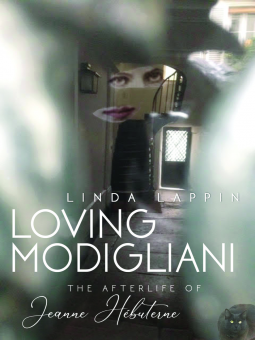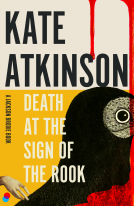
Loving Modigliani
The Afterlife of Jeanne Hébuterne
by Linda Lappin
This title was previously available on NetGalley and is now archived.
Send NetGalley books directly to your Kindle or Kindle app
1
To read on a Kindle or Kindle app, please add kindle@netgalley.com as an approved email address to receive files in your Amazon account. Click here for step-by-step instructions.
2
Also find your Kindle email address within your Amazon account, and enter it here.
Pub Date 15 Dec 2020 | Archive Date 31 Mar 2021
Talking about this book? Use #LovingModigliani #NetGalley. More hashtag tips!
Description
Amedeo Modigliani, embittered and unrecognized genius, dies of meningitis on a cold January day in Montparnasse in 1920. Jeanne Hébuterne, his young wife and muse, follows 48 hours later, falling backwards through a window. Now a ghost, Jeanne drifts about the studio she shared with Modigliani—for she was not only his favorite model, but also an artist whose works were later shut away from public view after her demise. Enraged, she watches as her belongings are removed from the studio and her identity as an artist seemingly effaced for posterity, carried off in a suitcase by her brother. She then sets off to rejoin Modigliani in the underworld. Thus begins Loving Modigliani, retelling the story of Jeanne Hébuterne’s fate as a woman and an artist through three timelines and three precious objects stolen from the studio: a notebook, a bangle, and a self-portrait of Jeanne depicted together with Modi and their daughter. Decades later, a young art history student will discover Jeanne’s diary and rescue her artwork from oblivion, after a search leading from Paris to Nice, Rome, and Venice, where Jeanne’s own quest will find its joyful reward.
Best-selling mystery novelist Gigi Pandian comments: “Part ghost story, part murder mystery, part treasure hunt, Linda Lappin’s Loving Modigliani is a haunting, genre-bending novel that kept me turning the pages long into the night.”
A Note From the Publisher
Loving Modigliani is available in print and all ebook formats.
Advance Praise
"Part ghost story, part murder mystery, and part treasure hunt, Linda Lappin's Loving Modigliani is a haunting, genre-bending novel that kept me turning the pages long into the night. "
--Gigi Pandian, author of The Alchemist's Illusion
“…this scintillating tale is also a love story, a ghost story, and a treasure hunt through the decades for a lost masterpiece….A novel of high originality, page-turning pace, and a poetic precision so impeccably deployed that the book unfolds like a living, breathing, 3–D spectacle in the reader’s mind. “ Don Wallace, author of The French House
A living map of Montparnasse, imbued with the colors and forms of classical poetry. A tour de force and a wild ride.” – James Wallenstein, author of The Arriviste.
Ambitious…courageous…compelling…unique. The atmosphere in Loving Modigliani is so vivid and imaginative, the characters incredibly rich. Miriam Polli, author of In a Vertigo of Silence.
Marketing Plan
blog tours, videos, interviews and online events with bloggers and vloggers devoted to modern art, Paris, and fiction.
Lappin also blogs at magiclibrarybomarzo.wordpress.com
blog tours, videos, interviews and online events with bloggers and vloggers devoted to modern art, Paris, and fiction.
Lappin also blogs at magiclibrarybomarzo.wordpress.com
Available Editions
| EDITION | Paperback |
| ISBN | 9781947175303 |
| PRICE | US$15.99 (USD) |
Featured Reviews
Linda Lappin beautifully opens the world of Jeanne Hebuterne in Loving Modigliani.
Jeanne was an artist, the common law wife of painter Amedeo Modigliani and the mother of his child. Tragically, twenty four hours after Modigliani’s death from meningitis she commits suicide by falling backwards from a upper floor window, killing herself and unborn child.
The ghost of Jeanne haunts the studio she shared with Modi. Her art and her identity as an artist vanished soon after her death. Her story is shared through several timelines and several treasured objects taken from the studio, a bangle, a portrait of Jeanne, Modigliani, their child and a diary.
With each page the reader is enveloped in the excitement and color of the Parisian art world and the struggles of those that created incredible works of art. Lappin’s prose paint a detailed portrait of the life of the talented but sadly tragic life of Jeanne Hebuterne. Part history, mystery, biography, this novel Is a page turner that has it all.
Thank you NetGalley, Serving House Books and Linda Lappin for this highly enjoyable and recommended novel.
Part ghost story, part murder mystery, and part treasure hunt, Linda Lappin's Loving Modigliani is a haunting, genre-bending novel that kept me turning the pages long into the night.
Thank you NetGalley and Serving House Books for sending me a copy of this novel to review.
Most people have heard of the artist, Amedeo Modigliani, but how many are aware of his model and long-term mistress/possibly wife, Jeanne Hébuterne, who was an artist in her own right. In Linda Lappin’s hands, her life and her after-life, are the subject of this unusual and tightly-plotted novel.
The novel starts in 1920, with the death of Jeanne Hébuterne. Most accounts of her life mention that she committed suicide after the death of her lover. In Lappin’s version, after a row with her brother, André, she falls from the window of his house on the fourth floor. Strangely enough the body is left covered with a sheet till the next morning when it is carried in a wheelbarrow to Modigliani’s studio for its final disposal. Lappin conveys in a vivid and compelling manner the hustle and the bustle of early morning Paris with the aroma of freshly baked bread and coffee emanating from cafes.
Then follows an interesting after-life section when Jeanne is determined to find Modigliani. This section, though imaginative and very readable, seems to be needlessly drawn out till the story moves to 1981 where we are introduced to a young art student who is spending a year in Paris to write a thesis on Manuel Ortiz de Zarate who lived in the same building as Modigliani. As part of her research, she meets Annie Rosier who was a maid with Ortiz family and who convinces her to make Jeanne the subject of her research.
Annie presents her with Jeanne’s diaries, through which we learn about her intense relationship with Modigliani, her family’s disapproval of this relationship, Modigliani’s affairs with his models, his philandering ways, the birth of their daughter, her second pregnancy and Modigliani’s death.
The story moves several years further to 2021 where an American lady, Dotoressa Cuomo, is curating an exhibition of the work of Jeanne Hébuterne for the Raphael Foundation of Venice. Jeanne has finally got her place in the art world and a single sketch has been auctioned for 60,000 euros
The novel is a love story between Jeanne and Modigliani, a ghost story with the narration of Jeanne’s after-life and a mystery story about a missing painting. Lappin keeps the reader’s interest throughout the novel and, it is in the final section that Lappin brings together very skillfully all the various threads to a mysterious conclusion.
Lappin guides us through an underworld in the Paris catacombs, a creepy villa outside Rome, ornate and squalid Montparnasse studios, a swanky Venetian palazzo and much more to reveal a rich world peopled with artists, dealers, students, crooks, and mysterious strangers. If life has grown dull, if you can't travel right now, and want to, ease into the armchair, open LOVING MODIGLIANI, and get ready for a whirlwind journey!
Linda Lappin’s Loving Modigliani tells the story of the life and afterlife of Jeanne Hébuterne, who was Modigliani’s common-law wife - and a talented budding artist in her own right.
We meet Jeanne in 1920, when she falls from a window just days after Modigliani dies of consumption. From there, we follow her into the afterlife, transcending space and time as she angrily watches family and acquaintances pick over her possessions, then crosses into a world of the dead, where she begins a long and arduous quest to be reunited with her beloved.
Jeanne’s story is picked up by an art student in Paris in 1981, who comes into possession of Jeanne’s diaries thanks to an old woman who is not all she seems. We also see a bracelet and lost painting of Jeanne’s move from place to place over the course of the book, until her work finally starts receiving the recognition it deserves, a century after her death.
I really enjoyed both the ‘life’ and ‘afterlife’ elements of this novel. The ‘other side’ Lappin creates - featuring talking cats, black stars, and inescapable bureaucracy among many other things - is highly vivid and imaginative.
The account of Jeanne’s short life contained in her diaries, meanwhile, is incredibly interesting and moving. I could really feel Jeanne’s excitement about going to art school in Paris, reinventing herself away from her stuffy bourgeois family, and falling madly in love for the first time. I also felt so sad, though, because she died at such a young age while ostracised by her family for getting pregnant out of wedlock, and Modigliani could be a drunken, abusive nightmare.
Jeanne’s story reminded me of a few other books I’ve read this year that show male artists treating their partners badly and overshadowing them - Christine Dwyer Hickey’s The Narrow Land, Whitney Scharer’s The Age of Light, Brigitte Benkemoun’s Finding Dora Maar and Polly Samson’s A Theatre for Dreamers come to mind. At least the women in these other books got to live full lives, whereas we can only imagine what Jeanne might have achieved had she survived. It is a balm to see her work on exhibition in the final section and find out about her posthumous success in the afterword.
The storyline with the art scholar also really captured my imagination. I always love reading about people making brilliant discoveries through research, so it really piqued my interest when she made contact with an eccentric but wily old woman, Annie Rosier, who knew Jeanne and was finally prepared to give up her secrets. There’s a lot of humour in this section as the pair go on a spontaneous, madcap trip across Europe to liberate the lost painting, involving comical characters and mightily suspicious deaths.
Loving Modigliani is imaginative, poignant and intriguing.
 Jacqui B, Reviewer
Jacqui B, Reviewer
We are with nineteen-year-old Jeanne Hébuterne as she falls to her death, just days after her lover, the artist Modigliani, dies. It is a brutal death and together with her trapped spirit we witness the horror on her family’s faces as they see her crumpled, broken body in the courtyard of their Parisian apartment.
As Jeanne comes to terms with what she has done, we are with her as she takes her first steps in the afterlife, desperate to do all she can to be reunited with her beloved Modi. With the help of unexpected new friends, she travels through portals that take her between a seemingly parallel Paris for the dead, the underworld, and even give her a glimpse into the future she missed. Death for Jeanne is like a dream where you never quite seem to get where you need to be, and where increasingly bizarre situations crop up to delay your progress.
This is a book of many parts, each one as intriguing as the other. No sooner had I got settled into the afterlife, when we are transported back to Paris, in the 1980’s, where an art student writing her thesis is introduced to a mysterious elderly lady. Annie is one of the last people alive to have met Modi and Jeanne, but time is running out for her and she has secrets she needs to share, before it is too late.
When Jeanne’s diaries turn up unexpectedly, decades after her death, the next part of this book takes us back into Montparnasse and the Parisian art scene during the First World War. The parties, the deceit, the poverty, the passion. We follow the young Jeanne as she begins to break away from the safety of her bourgeois family and find her independence with the artists she so admires.
Each different part of this book captivated me and swept me up in the mystery of Jeanne’s life, and the final part, which was probably the most unexpected, brought everything together just perfectly and left me with a smile on my face.
With Jeanne’s life and death being such an enigma, this isn’t the first fiction book I have read about her, and it certainly left me wanting to know more about Jeanne, Modi, his art, and their daughter. I couldn’t have picked a better book to begin a new year of reading.
 Celia P, Reviewer
Celia P, Reviewer
This narrative is based on a real person Jeanne Hébuterne, the 'wife' of Amadeo Modigliani, an Italian Jewish painter and sculptor who worked mainly in France. His nickname is Modi.
Jeanne Hébuterne was a French artist best known as the frequent subject and common-law wife of the artist Amedeo Modigliani. She took her own life two days after Modigliani died, and is now buried beside him. They both died in 1920.
I initially became interested in this book because my favorite genre is historical fiction. I LOVED the book, but let me tell you: THIS IS NO ORDINARY HISTORICAL FICTION.
Written in 6 parts, the first is entitled "Afterlife A Gothic Fairy Tale Out the Window January 26, 1920". We meet Jeanne as a dead person. All her thoughts are seen from the other side. She had jumped out a window to her death. Thinking as a dead person might..how immensely fascinating. Extremely imaginative too. Highlights: 1) the Paris of the Dead. Did you know that there is another Paris where only dead people live? 2) the trial of Jeanne because she was accused of double murder - her own and her unborn child.
Jeanne is looking for Modi. Will she be allowed to be with him where he now resides... with the Immortals?
Part 2 "Ghosts of Montparnasse The Missing Madonna 1981". An art student has come to Paris for a year to write a thesis on the Chilean artist, Manuel Ortiz de Zarate, whose studio was once located on these premises in the glorious years of Montparnasse. Modigliani had worked in the upstairs loft of these premises. She meets Annie Rosier who had been a model for Ortiz. Annie is more interested in talking about Modi than Ortiz. She mentions the Missing Madonna, a portrait of Jeanne and her baby girl, started by Modi and finished by Jeanne.
Part 3 "The Notebooks of Jeanne Hébuterne" relates her life with her family and with Modi. These notebooks were bequeathed to the student by Annie. They are worth a fortune.
Part 4 "The Missing Madonna 2". Annie and the student set off for Nice... looking for The Missing Madonna. Annie then says that it is too dangerous in Venice and they continue their journey to attempt to find the painting in Rome.
Part 5 "Afterlife"
Part 6 "The Holy Family of the Circus Venice, 2021"
The story was well constructed. The phrasing was flawless; I do not think there was a word out of place. The last two parts were completely surprising to me and I leave them un-described. I leave it to the reader of this review to PLEASE READ THE BOOK.
This is my first book by Lapin. It won't be my last. I originally got a free copy from the author in exchange for an honest review. I loved it so much, I paid for the Kindle copy. The review was a real pleasure to write. Will remember this book for a long time. Definitely in my top 10 for the year 2020 and my lst book to finish this year.
5 stars
This book was a wild run.
It begins when Jeanne Hebuterne committed suicide on January 26, 1920 two days after her husband, Amedeo Modigliani died from a long illness of tuberculosis. She was 10 months pregnant with her second child and couldn't bear to live without him as she jumped out of a window. What's different is that in the beginning of the book, Jeanne is witnessing what has happened in the afterlife. A thin thread connects her ghost self to her body as she takes a glimpse of her life.
Jeanne's friends warned her about a life with Modigliani. It was well known that he was intimate with his models, he took drugs, he spent every penny he had at the bar and felt like a failure with his art. Yet, Jeanne overlooked these traits and said she didn't need money to be happy. It didn't matter that her mom, dad and brother were horrified that she left her family with an excellent reputation to be with this older man that was not only a starving artist but also Jewish. None of this mattered to her. This book was unique as Jeanne always wanted to be closely connected to the one she loved even after she died.
As the book continues, the reader learns more about Jeanne when years later, her notebooks with sketches, drawings, shopping lists, poems and words are revealed to an American art history student working on her doctorate. Maybe it's not exactly how a young Paris girl would write a diary in those days but it was filled with a bit of mystery that made me want to find out more.
They are many written reports and books about the high profile male Paris artists of the 1920s: Mondigliani, Cezanne, Turner, Gauguin, and Picasso. However, what about the women that married these men? Of course, it was a woman that decided to write about the artist that is not as well known: Jeanne Hebuterne. It was clear that an incredible amount of historical research was done to bring accuracy to this story.
Overall, with a love of art, I enjoyed this book. My thanks to the author, publisher and NetGalley for allowing me to read this e-book in exchange for an honest review.
 Tara C, Librarian
Tara C, Librarian
Propping open the doors of intrigue, there's a triangle of light that reveals the romanticized mystique of the relationship between artist Amedeo Modigliani and Jeanne Hebuterne. There's a triad of sorts that Lappin applies as a vehicle to explain the passion of Jeanne Hebuterne, as this is her story and Modigliani only exists as a flickering candle, whisps of smoke reminding us he was there. And that is okay because what is explored is Hebuterne in life, and then her death that feels like you've left one novel and started reading a Neil Gaiman novel for a bit. But, yet another story emerges as we are introduced to a young art student and now we've jumped ship into an adventurous quest to solve the mysterious disappearance of the Modigliani family portrait featuring Hebuterne, Modigliani, and their infant daughter. As each section of the story closes, it is a roll of the dice to see where you land while grasping the pieces of Hebuterne's life that swirl around. Finally, we land in the present, in post-Carnival Venice, where Hebuterne and Modigliani are seemingly reunited.
Give in to the chaos and follow the story to the end. There's merit to applying Kabbalah theories and literary analysis to uncover symbolism that helps organize the story into a meaningful study of passion and art.
Loving Modigliani is one of those books that is so good that I don’t feel my review will do it justice. It is so good that I stopped halfway through and bought it in print version because I only had an electronic copy. I always keep print copies of my favorite books. It is so good that I didn’t want to put it down, and I was sad when it was finished. This is my humble attempt at a review and my bow to an accomplished author, Linda Lappin, who has woven together a remarkable piece of fiction based on real events.
It is Paris, 1920. It is also Jeanne Hébuterne's day of death, 48 hours after her common-law husband, Amedeo Modigliani, died of tuberculosis. Modigliani was an artist of portraits and nudes who died basically destitute, but became famous years later. As the book begins, we meet Hébuterne on the street where her body lies after she fell or jumped, despondent and hugely pregnant, out of a window. We follow her spirit to a wheelbarrow rumbling through the streets of 1920's Paris, which is described in such detail that we feel we are there. We watch along with Hébuterne’s spirit as her belongings are stolen, including her diary, a bangle, and a family portrait. We flash back with her to her life with Modigliani and her own growth as an artist. We cheer her as she struggles to move forward and begins to search the afterlife for her beloved “Modi.”
In a separate timeline in the 1980s, an art student stumbles upon some long hidden secrets and is given a window into the life of Jeanne Hébuterne. What will she do with this information and who will try to stop her?
This is an amazing historical novel with sub-genres of fantasy, mystery, and the paranormal. It is a tribute to the art world of Paris, specifically the post-impressionist era of the early 1900s. Linda Lappin’s ability to describe the sights, sounds, and smells of 1920's Paris transports us there immediately. Her portrayal of the art and artists of that time is meticulously researched. Her ability to create a work that seamlessly binds together history, mystery, fantasy, and the paranormal is awe-inspiring. Her characters are so real you can see them, feel them, love them, and hate them. Lappin’s description of Hébuterne’s afterlife is full of unexpected turns, pitfalls, and surprises with huge nods to the art world. The realities of Jeanne’s life with Modigliani are shown to us, from infidelity to drunkenness to abuse and neglect, but above all we are shown Jeanne’s all-consuming love for this man, so well described in this book. Lappin shares the spirit and talent of Jeanne Hébuterne in so many ways, through her art, her music, and her steadfast determination and willingness to buck the rules of society. I wish I could speak more of the last line of the book without giving out any spoilers, but it is a perfect ending, tying everything together.
My personal rules for historical novels, regardless of sub-genre, is that they must transport me to that time and place. Loving Modigliani did this instantly. They must also teach me something, and I learned so much about the 1900s Paris art scene that I am interested into exploring it further.
Although I was given a free digital copy via Netgalley, I also bought a copy on Amazon. My review is voluntary and my opinions are my own.
Novel set in across 20th Century Montparnasse
I think many people will have heard of the artist Amedeo Modigliani but few will have heard of Jeanne Hébuterne, his common law wife and mother to his child. I studied art history and had never heard of her until now. The author has chosen to set this woman centre stage in her novel. Hébuterne too was an artist but somehow never shone, as she lived her short life in the shadow of her husband, who was, at times, a feckless womaniser but a man with incredible talent.
The book is divided into different sections and the first one features Jeanne after she took her own life in 1920 (at age 22 and pregnant with their second child), just a couple of days after Modigliani died of meningitis. The story opens as she is lying dead on her death bed, observing the procession of people who are involved in the aftermath of her death. From where she lies, she is aghast at the pilfering of her personal belongings, yet she can do nothing. After interment, she descends into the underworld where she searches for Modigliani. The narrative bowls along, with an impressive monochrome visual palette adding a real sense of bleakness, as she navigates her way among the dead souls, a mass of humanity. She is tried for the sin of suicide and eventually finds her way back to the surface where time has moved on and the Nazis have arrived in her home city. She discovers that Modigliani’s work is being censured, appearing in exhibitions of degenerate art.
I am not generally drawn to novels where the afterlife is part of the narrative but I felt this worked well, it is very atmospherically rendered and I found it very readable.
It is 1981 and an art history student has arrived in Paris, researching Manuel Ortiz de Zarate, who happened to live in the same building as Hébuterne and Modigliani, and she is seduced by the story she hears about Hébuterne: maybe some of the works of Modigliani were perhaps – at least in part – attributable to her? She is now on a quest to discover more.
The story continues and more is revealed about Hébuterne’s life. The author is incredibly good at evoking the sense of time and place and I felt transported back to early 20th Century Paris. I think it is wonderful that such a little known female artist has been given centre stage in this novel.
Here the author writes a piece for Travel Writing World about the setting of her novel, Montparnasse.
Readers who liked this book also liked:
Bonnie Kelso (co-author and illustrator), Kentee Pasek (co-author)
Children's Nonfiction, Entertainment & Pop Culture








